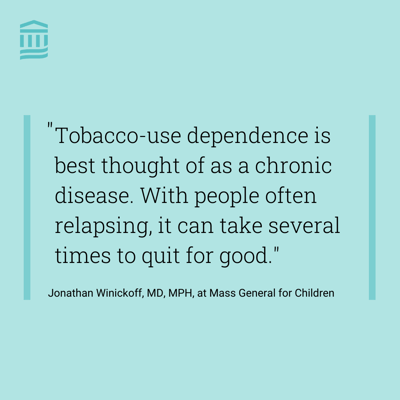This is why kids are more susceptible to tobacco addiction
In recognition of World No Tobacco Day on May 31, we met with Jonathan Winickoff, MD, MPH, at Mass General for Children. Dr. Winickoff has over 20 years of experience as a general pediatrician and researcher specializing in family health and tobacco control. He has researched and successfully advocated raising the tobacco sales age to 21, making public housing smoke-free, and has changed the way pediatricians help family members quit tobacco use. He also recently testified before Congress about the youth vaping epidemic. Continue reading to learn why kids and adolescents are more susceptible to tobacco addiction along with the immediate benefits of quitting.
 Throughout his medical training and career, Dr. Winickoff has researched youth and adult tobacco control issues. Before beginning medical school, he backpacked across the Philippines and participated in various health projects. Arriving in Panay, the first thing that Jonathan recognized was American cigarettes, made readily available to adults and children; they could buy them one at a time for pennies. Dr. Winickoff described, “There were very high malnutrition rates in this village, yet youth and adults were spending money on US tobacco products. One day I saw a 10-year-old boy who walked down the town center with two lit cigarettes at once. He wore old clothes and broken flip flops but had used his little money to purchase these cigarettes, showing just how early the process of addiction started in the village of Mala-iba.”
Throughout his medical training and career, Dr. Winickoff has researched youth and adult tobacco control issues. Before beginning medical school, he backpacked across the Philippines and participated in various health projects. Arriving in Panay, the first thing that Jonathan recognized was American cigarettes, made readily available to adults and children; they could buy them one at a time for pennies. Dr. Winickoff described, “There were very high malnutrition rates in this village, yet youth and adults were spending money on US tobacco products. One day I saw a 10-year-old boy who walked down the town center with two lit cigarettes at once. He wore old clothes and broken flip flops but had used his little money to purchase these cigarettes, showing just how early the process of addiction started in the village of Mala-iba.”
In that village, Dr. Winickoff set up a series of meetings with high school students. Together, they started an Anti-Smoking Committee developing initiatives that made schools smoke-free throughout the province. From there, Dr. Winickoff connected with local pediatricians and OBGYN doctors, eventually meeting with the Secretary of Health of the Philippines, Doctor Juan Flavier, to tell the story of what the youth had accomplished. Dr. Flavier gave a major public health award and plaque to display outside of the local health center to recognize the community and clinician collaboration the youth of Mala-iba had inspired. When Juan Flavier later became a senator in the Philippines Congress, he introduced and then passed a smoke-free workplace law throughout the Philippines—one of the first countries in the world to do that. Dr. Winickoff added, “It was really exciting to have this early career experience working with youth; the impact of that experience really motivated me to do more in the United States with tobacco control issues.”
Physical and mental implications of smoking
Many adolescents assume that electronic cigarettes or other forms of tobacco will relieve stress, however, recent research points to an increased level of mental health problems, mood disorders, and increased stress for those who use tobacco products. Dr. Winickoff elaborated, “Once you go into withdrawal because you can't use your product, you become stressed and worried. The advertising around stress reduction that the tobacco industry puts out there is really a false message, but it's a very effective one for getting youth into using tobacco.”
 Approximately 95% of new tobacco users are under the age of 21. If you make it to the age of 21 as a non-tobacco user, you only have a 2% chance of becoming a tobacco user. The tobacco industry knows this, which is why they strategically target products to youth; their goal is to get young brains addicted and hope they become lifelong customers. Dr. Winickoff explained, “The frontal cortex is in a state of development through the age of 25. That’s why youth get addicted to less nicotine, at a faster pace—and it's harder for them to quit.”
Approximately 95% of new tobacco users are under the age of 21. If you make it to the age of 21 as a non-tobacco user, you only have a 2% chance of becoming a tobacco user. The tobacco industry knows this, which is why they strategically target products to youth; their goal is to get young brains addicted and hope they become lifelong customers. Dr. Winickoff explained, “The frontal cortex is in a state of development through the age of 25. That’s why youth get addicted to less nicotine, at a faster pace—and it's harder for them to quit.”.png?width=392&height=392&name=LIZ-%20Posts%20wrapped%20in%20blog%20III%20(1).png)
Quitting
The younger you start smoking, the harder it is for you to quit, but people can quit at any age and immediately reap the benefits. FDA-approved nicotine replacement therapies including nicotine patches, gum, and lozenges are available over the counter or with a provider prescription to help individuals quit. There are also two FDA-approved medications that are non-nicotine: varenicline and bupropion. These medications, coupled with nicotine replacement therapy, can double or triple the chances of someone successfully quitting. Medications are most effective when they're used with some form of counseling; that can be through a smoke-free text program on your cell phone or through individual counseling with an expert.
Addiction
Almost all regular users of tobacco products have some level of physical addiction to nicotine. So, for regular users, it is typically very challenging to stop using their products. Tapping into evidence-based medications and counseling can help those addicted to nicotine. It often takes anywhere from one to several attempts to quit so regular users should not get frustrated if they struggle during initial attempts to quit. Dr. Winickoff explains, “Tobacco-use dependence is best thought of as a chronic disease. With people often relapsing, it can take several times to quit for good.”
.png?width=434&height=434&name=LIZ-%20Posts%20wrapped%20in%20blog%20III%20(2).png)
Benefits of quitting
The benefits of quitting start happening almost immediately. People generally feel happier after they quit, as they tend to have fewer health issues, such as asthma attacks, and over time, their rate of developing lung cancer goes down. Quitting also prompts major benefits to the cardiovascular system with blood pressure and heart rate dropping within an hour of quitting. Rates of heart attack start to go down after a couple of years but may take 10-15 years before the risk is like someone who has never smoked.
Read part 2 of our conversation with Dr. Winickoff, where he discusses the unknowns around vaping and how parents can talk to kids about prevention.
For a fresh perspective on overall health and wellness, download our free eBook.
